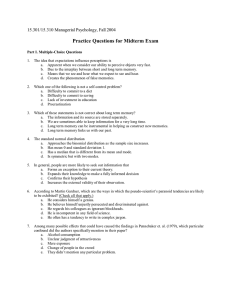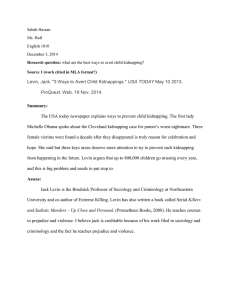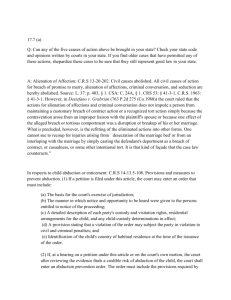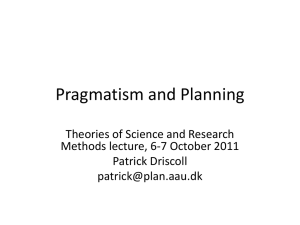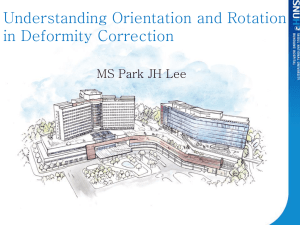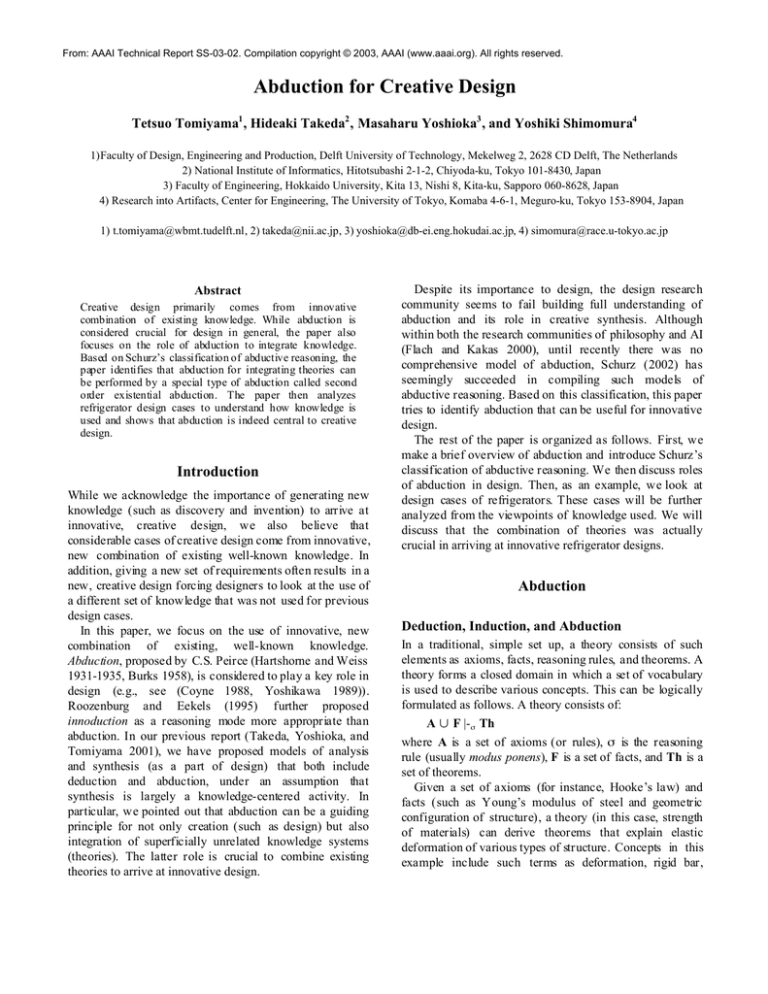
From: AAAI Technical Report SS-03-02. Compilation copyright © 2003, AAAI (www.aaai.org). All rights reserved.
Abduction for Creative Design
Tetsuo Tomiyama1 , Hideaki Takeda2 , Masaharu Yoshioka3 , and Yoshiki Shimomura4
1) Faculty of Design, Engineering and Production, Delft University of Technology, Mekelweg 2, 2628 CD Delft, The Netherlands
2) National Institute of Informatics, Hitotsubashi 2-1-2, Chiyoda-ku, Tokyo 101-8430, Japan
3) Faculty of Engineering, Hokkaido University, Kita 13, Nishi 8, Kita-ku, Sapporo 060-8628, Japan
4) Research into Artifacts, Center for Engineering, The University of Tokyo, Komaba 4-6-1, Meguro-ku, Tokyo 153-8904, Japan
1) t.tomiyama@wbmt.tudelft.nl, 2) takeda@nii.ac.jp, 3) yoshioka@db-ei.eng.hokudai.ac.jp, 4) simomura@race.u-tokyo.ac.jp
Abstract
Creative design primarily comes from innovative
combination of existing knowledge. While abduction is
considered crucial for design in general, the paper also
focuses on the role of abduction to integrate knowledge.
Based on Schurz’s classification of abductive reasoning, the
paper identifies that abduction for integrating theories can
be performed by a special type of abduction called second
order existential abduction. The paper then analyzes
refrigerator design cases to understand how knowledge is
used and shows that abduction is indeed central to creative
design.
Introduction
While we acknowledge the importance of generating new
knowledge (such as discovery and invention) to arrive at
innovative, creative design, we also believe that
considerable cases of creative design come from innovative,
new combination of existing well-known knowledge. In
addition, giving a new set of requirements often results in a
new, creative design forcing designers to look at the use of
a different set of knowledge that was not used for previous
design cases.
In this paper, we focus on the use of innovative, new
combination of existing, well-known knowledge.
Abduction, proposed by C.S. Peirce (Hartshorne and Weiss
1931-1935, Burks 1958), is considered to play a key role in
design (e.g., see (Coyne 1988, Yoshikawa 1989)).
Roozenburg and Eekels (1995) further proposed
innoduction as a reasoning mode more appropriate than
abduction. In our previous report (Takeda, Yoshioka, and
Tomiyama 2001), we have proposed models of analysis
and synthesis (as a part of design) that both include
deduction and abduction, under an assumption that
synthesis is largely a knowledge-centered activity. In
particular, we pointed out that abduction can be a guiding
principle for not only creation (such as design) but also
integration of superficially unrelated knowledge systems
(theories). The latter role is crucial to combine existing
theories to arrive at innovative design.
Despite its importance to design, the design research
community seems to fail building full understanding of
abduction and its role in creative synthesis. Although
within both the research communities of philosophy and AI
(Flach and Kakas 2000), until recently there was no
comprehensive model of abduction, Schurz (2002) has
seemingly succeeded in compiling such models of
abductive reasoning. Based on this classification, this paper
tries to identify abduction that can be useful for innovative
design.
The rest of the paper is organized as follows. First, we
make a brief overview of abduction and introduce Schurz’s
classification of abductive reasoning. We then discuss roles
of abduction in design. Then, as an example, we look at
design cases of refrigerators. These cases will be further
analyzed from the viewpoints of knowledge used. We will
discuss that the combination of theories was actually
crucial in arriving at innovative refrigerator designs.
Abduction
Deduction, Induction, and Abduction
In a traditional, simple set up, a theory consists of such
elements as axioms, facts, reasoning rules, and theorems. A
theory forms a closed domain in which a set of vocabulary
is used to describe various concepts. This can be logically
formulated as follows. A theory consists of:
A » F |-s Th
where A is a set of axioms (or rules), s is the reasoning
rule (usually modus ponens), F is a set of facts, and Th is a
set of theorems.
Given a set of axioms (for instance, Hooke’s law) and
facts (such as Young’s modulus of steel and geometric
configuration of structure), a theory (in this case, strength
of materials) can derive theorems that explain elastic
deformation of various types of structure. Concepts in this
example include such terms as deformation, rigid bar,
torsion, etc. This reasoning mode is deduction to obtain Th
from A and F, while abduction obtains F from A and Th,
and induction A from F and Th. In this formalization, there
are two important structural elements of a theory; i.e.,
axioms and concepts, which define the target domain.
Models of Abuductive Reasoning
Schurz (2002) has compiled a (seemingly) complete model
of abduction that classifies various types of abductive
reasoning. Table 1 shows his classification in which
indentation means a subcategory of the super. Note that his
classification does not imply clarification about all the
necessary computational algorithms: there are still many
tasks to be accomplished.
According to him, basically there are three fundamental
models of abduction; i.e., factual abduction, law-abduction,
and second order existential abduction. Factual abduction
is the simplest form of abduction in which both evidences
to be explained and abductive conjectures are always
singular facts.
For example, observable-fact abduction is a reasoning to
obtain
F ={C(a)}
from
A = {C(x) Æ E(x)}
and
Th = {E(a)},
which is simply retroduction or backward reasoning. First
order existential abduction is a special form of this factual
abduction and generates a as a variable to be instantiated.
Law-abduction creates theoretical hypotheses and it is
closely related to induction. Schurz (2002) explains as
follows: given a background law,
"x(C(x) Æ E(x)): Whatever contains sugar tastes
sweet,
and an empirical law to be explained,
"x(F(x) Æ E(x)): All pineapples taste sweet,
we may obtain
"x(C(x) Æ F(x)): All pineapples contain sugar.
Second order existential abduction contrasts to the two
categories of abduction in that it generates “at least partly
new general property or natural kind of concept together
with an at least partly new theoretical law.”
For instance, Schurz points out that analogical abduction
generates a statement, “Sound consists of atmospheric
waves in analogy to water waves,” from background laws
“Laws of propagation and reflection of water waves” and
phenomenon to be explained “Propagation and reflection
of sound.”
Table 1. Classification of Abduction
modified from (Schurz 2002)
Abduction
Factual
abduction
Observablefact abduction
Unobservable
-fact
abduction
Historicalfact
abduction
Theoretical
-fact
abduction
First order
existential
abduction
Evidence
to be
explained
Singular
empirical
facts
Abduction
produces
Abduction is
driven by
New facts
Known laws
or theories
↑
Factual
reasons
Unobservable
reasons
Known laws
↑
Facts in the
past
↑
↑
New initial or
boundary
conditions
Factual
reasons
postulating
new unknown
individuals
New laws
Known
theories
New laws/
theories with
new concept
Microscopic
composition
Theoretical
background
knowledge
Extrapolative
background
knowledge
Analogy
with
background
knowledge
Causal
background
knowledge
↑
↑
Law-abduction
Empirical
laws
Second order
existential
abduction
Micro-part
abduction
↑
↑
Analogical
abduction
↑
Missing-link
commoncause
abduction
Fundamental
commoncause
abduction
Theoretical
property
abduction
Abduction
to reality
↑
↑
↑
↑
New laws/
theories with
analogical
concepts
Hidden
common
causes
New
unobservable
properties and
laws
New
theoretical
entities
External
entities
↑
Known laws
Known laws
Unification
of
background
knowledge
↑
↑
Analogical abduction
results from
conceptual
combination based on isomorphic mapping. An example is
shown in Figure 1 depicting an electric circuit system and a
lumped mass system. For the both systems, an identical
Resistance
+
Capacitance
Ú dt
Voltage
Current
dt
Inductance
(b) Electric Circuit System
Mass
Abduction for Creation
+
Damping
Ú dt
Acceleration
Force
Stiffness
conductivity of electricity, characteristic flexibility and
elasticity, hardness, characteristic glossing.” Then, we
might suppose that “there is a really existing material
characteristics which is the common cause of all these
empirical” propositions, which is metallic character, M(x).
We may say:
"x(M(x) = "t(C i (x, t) fi Ei (x, t))).
From this, we actually create metallic character that unifies
those theories about behaviors such as heat conductivity,
electricity conductivity, flexibility, elasticity, etc.
ÚÚdtdt
(a) Lumped Mass System
Figure 1: Two Isomorphic Systems
differential equation holds, because there exist isomorphic
mappings of system parameters between these two systems
(naturally, we need an additional piece of mathematical
knowledge about linear ordinary differential equations).
In Schurz’s classification, another interesting model of
abduction is fundamental common cause abduction that
generates “a new unobservable property together with laws
connecting it with observable properties.” It could be
formalized as abduction from observed effects:
F(x) Æ G(x) (where F, G are observable properties)
to generate
F(x) Æ x has causal power P F/G(x), which produces
G(x).
A special kind of fundamental common cause abduction
is theoretical property abduction. In this case, from a
number of correlated observations, one observation seems
to explain all of them. Assume we have a set of
propositions for some but not all objects x:
"t(C i (x, t) fi Ei (x, t)) 1 ≤ i ≤ n
in which fi means “an implication stronger than material
one, e.g., counterfactual or law-like implication.” Now
assume that “all these empirical laws are themselves
correlated in the following way”:
"x("t(C i (x, t) fi Ei (x, t)) = "t(C j (x, t) fi Ej (x, t))
1 ≤ i < j ≤ n.
In such a case, there must be a unifying explanation for all
of these propositions; this creates a new theory.
An example given by Schurz is that “Whenever an
object exhibits conductivity of heat, it also exhibits
Within the design research community, it is often pointed
out that synthesis is largely performed by abduction in the
sense of factual abduction (Coyne 1988, Yoshikawa 1989).
Indeed, first order existential abduction generates an entity
that performs the given requirements.
While philosophically this analogy seems valid,
computationally (or from the design point of view), we can
see that factual abduction does not really lead to creative
and innovative design. First, it generates facts from a
known set of axioms and theorem (i.e., requirements) in a
domain which is more or less covered by the axioms. In
this sense, such a mode of abduction cannot go beyond
what the axioms cover nor result in creative design. This
can be seen in the formalization: Given:
A = {C(x) Æ E(x)}
and
Th = {E(a)},
obtain
F ={C(a)}
as a design solution. To computationally perform this type
of abduction, we must be given a knowledge base that
contains a and a should satisfy C(a), before even we design.
This means that we should know the solution before we
design and that design boils down to search problems.
Figure 2 depicts this situation. First, we are given axioms
as background knowledge and theorems as requirements.
Factual abduction generates facts that describe a design
solution. If given different requirements (i.e., a different
enclosing domain), we arrive at different design solutions.
However, these domains are already implicitly defined by
axioms!
One another important mode of abduction is theoreticalfact abduction that generates new initial or boundary
conditions. In the design context, this type of abduction
generates new sub design problem or additional
requirements. Therefore, it is also of great relevance to
design.
Axioms
{house(X) Æhas(X, roof),
has(X, roof) Æcomfortable(X)}
Facts
{house(a)}
Theorems
{comfortable(a)}
Figure 2: Factual Abduction
Abduction for Integration
While abduction is a crucial concept as discussed in the
previous section, abduction also plays another important
role in integrating multiple theories (Takeda, Yoshioka,
and Tomiyama 2001). Given a problem and a set of
theories, if judged impossible to find a solution within the
domain, abduction can introduce an appropriate set of
relevant theories to form a new set of theories, so that
solutions can be found with the new set of theories. For
instance, as long as our knowledge is limited to the
structural strength of materials of given shape, we will
never reach such an innovative design as “drilling holes”
for lighter structure while maintaining the strength. This is
only possible when we have a piece of knowledge that
removing material that does not contribute to strength does
not make any harm but only makes the whole object lighter.
Figure 3 depicts abduction for integrating theories. First,
we are given axioms 1 as background knowledge and the
combined domain of theorems 1and 2 as requirements.
However, we may notice that there is no way to arrive at
design solutions that can cover the domain designated by
theorems 2 with only axioms 1 (hence theorems 1). This
may request us to incorporate a new theory, i.e., axioms 2
that may be able to cover this domain. After factual
abduction using both of axioms 1 and 2, we may arrive at
facts 1 and 2 that describe a design solution for these
requirements.
However, notice that as a consequence of taking into
consideration additional axioms 2 besides axioms 1, we
effectively integrated axioms 1 and 2. This is an example
of innovative design coming from innovative combination
of knowledge. In Schurz’s classification, this abduction for
integrating theories seems to be carried out by combination
of modes of second order existential abduction.
For instance, we can think about the following two-step
algorithm to integrate multiple theories from different
domains (that are superficially irrelevant to each other);
first to identify the applicability and the domain of the
theories to be introduced, and second to integrate the new
set of theories. The first step identifies the relevance of the
structural elements of theories, i.e., axioms and concepts,
and very much the same as analogical abduction. The
second step actually does the integration based on, for
instance, theoretical-property abduction.
Refrigerator Design
To test the ideas described in the previous ideas in the
context of creative design, let us consider a conceptual
design of refrigerators (this example was inspired by (Suh
1990)). While refrigerators are originally simple devices,
today we can find a variety of sophisticated designs
depending on such requirements as capacity, cooling
temperature and humidity, how to store and handle food,
and where to use. Some examples of refrigerators that can
be found include traditional design with a large
compartment for normal temperature and a freezer (Figure
4), advanced design with multiple compartments including
drawer-type storage and even a door in a door (Figure 5),
and special design for supermarkets (i.e., a box with a
vertical opening but without lid or a showcase with
circulating cool air without loosing it like in Figure 6).
Axioms 1
Facts 2
Facts 1
Theorems 1
Axioms 2
Theorems 2
Figure 3: Abduction for Integrating Theories
Figure 4: Traditional Refrigerator Design
The next step is embodiment. For FR11, we may need an
enclosed space (E), and for FR12 an access method to it
(A). For FR21, as working principles we may use cooling
with cool air generated by a cooling device physically
realized by an evaporator of a cooling cycle (Cd). FR22
requires thermal conduction and insulation for the space
(Tc). We may employ other principle such as ice or
radiation, but of course this will result in another design.
Consequently, we obtain the following representation,
which again is a decoupled design.
Figure 5: Door-in-Door + Drawer Design
ÈFR11˘ Èx
Í
˙ Í
ÍFR12˙ = Íx
ÍFR21˙ Í0
Í
˙ Í
ÎFR22˚ Îx
0
0
x
0
0
x
0
x
0˘È E ˘
˙Í ˙
0˙Í A ˙
0˙ÍCd˙
˙Í ˙
x˚Î Tc˚
This decomposition can be continued until we identify
sufficient information regarding FRs and DPs with which
† we may proceed to basic design stage. For instance,
regarding the identified enclosed, cooled storage, we need
to consider accessibility. This requires a piece of
knowledge about accessibility of human hands to an
enclosed space. Our functional knowledge about
mechanisms tells that for horizontal access a door and a
sliding door are options, and for vertical access a lid or a
Figure 6: Showcase Design
sliding door. We may identify a trade-off here; having a
door for horizontal access may release cooled door,
Now let us analyze the most fundamental refrigerator
whereas doors for vertical access may not be good for food
design which has only one cooled space. In this paper, we
access.
employ the terminology of Suh’s axiomatic design (Suh
Traditional refrigerator design (Figure 4) is to have big
1990) to represent the relationships between functional
frontal
doors for horizontal access, which may sacrifice
requirements (FRs) and design parameters (DPs). The main
efficiency
by loosing cool air. More recent innovative
function requirements are:
designs include having smaller doors instead of a single big
FR1: to store food and to provide access to it, and
door, drawer-like design with cooled compartments for
FR2: to keep the food cool.
separate vertical access, or even having a smaller door in
Having defined FRs in this way, we obtain a little bit of
the big door (Figure 5). If we neglect efficiency and
embodiment. We need a storage space that should be
emphasize access, a box with a top opening without a lid
accessible (either from the front or from the top) and
can often seen in supermarkets for frozen food. An extreme
efficient enough to keep the food cool, as well as a cooling
design case is shown in Figure 6 to maximize customers’
device. Thus, we obtain two DPs, viz., a storage space (S)
convenience in supermarkets.
and a cooling device (C) resulting in the following
In these design examples, we notice that the knowledge
expression. (By the way, according to Suh (1990), this is a
describing accessibility was combined with the knowledge
decoupled design that is not necessarily a good design.)
about the behavior of cooled air for “better” designs. This
ÈFR1˘ Èx 0˘ÈS˘
combination process is exactly the result of abduction to
Í
˙=Í
˙Í ˙
integrate these two pieces of knowledge and illustrates the
ÎFR2˚ Îx x˚ÎC˚
power of “abduction for integration” to arrive at creative
Now, FR1 can be decomposed into:
design.
FR11: to store the food in storage, and
†
FR12: to access the food in the storage.
Analysis of Knowledge Use
The decomposition of FR2 depends on the embodiment,
and for instance, it can be decomposed into
To further test our claim that abduction for integration is a
FR21: to generate cool air, and
key to arrive at creative design, in this chapter we analyze
FR22: to maintain cool temperature in the storage
more formerly how this is done in the refrigerator design
with cool air.
examples. We can indeed logically interpret these
examples, using techniques of qualitative physics, in
particular, of naïve physics (Hayes 1985, 1985a).
Knowledge about Cooling
First, let us consider design knowledge we used for
embodying FR21 with Cd.
TH1: An evaporator of a cooling cycle cools objects
in the space.
This sounds somewhat fundamental and might be accepted
as a piece of fundamental knowledge. However, below we
would like to point out that even such seemingly
fundamental knowledge is a result of combination of more
fundamental knowledge. To obatain TH1, we first need
knowledge about heat transfer.
HT1: Heat is transferred through conduction from an
object of high temperature to one of low temperature,
if they contact each other.
This can be logically formalized using first order predicate
logic as follows. Notice, however, that we may need more
carefully treatment about temporal aspects and causality; to
do so, one may use more sophisticated logic systems such
as temporal logic than standard first order predicate logic.
HT1 = {contact (A, B) Ÿ temperature (A, Ta) Ÿ
temperature (B, Tb) Ÿ Ta>Tb Æ heat_transfer (A, B)}
The contact relationship is usually transitive and reflexive.
So we know:
C = {contact (A, B) Ÿ contact (B, C) Æ
contact (A, C), contact (A, B) Æ contact (B, A)}.
When heat transfer happens, the object with higher
temperature gradually cools down and the object with
lower temperature also gradually heats up, and eventually
they arrive at equilibrium. However, here we assume (for
the sake of simplicity) that the heat capacity of an
evaporator of a cooling cycle is sufficiently large, so that
the temperature of the evaporator can remain the same,
while this might not be the case for ice. In our case, after
heat transfer, the object touching the cooling source gets
cooler.
HT2 = {time (T0) Ÿ heat_transfer (A, B) Ÿ
evaporator (B) Ÿ temperature (A, Ta) Ÿ
temperature (B, Tb) Ÿ Ta>Tb Æ
time (T1) Ÿ temperature (A, Tb) Ÿ T0 << T1}
In addition, we need to have knowledge about cooling
sources. Such factual knowledge about entities and their
functionalities are organized as follows (Takeda et al.
1990):
FK1 = {ice (X) Æ cooling_soruce(X) Ÿ
temperature (X, 0°C)}
FK2 = {evaporator (X) Æ cooling_soruce(X) Ÿ
temperature (X, 0°C)}
Now, assuming that we use air as a medium to transfer
heat and that the temperature of any cooling source is
substantially below normal room temperature, i.e.,
AS1 = {cooling_source (C) Ÿ temperature (C, Tc) Ÿ
food (F) Ÿ temperature (F, Tf) Ÿ Tf > Tc Ÿ air (A) Ÿ
contact (C, A) Ÿ contact (A, F)},
our formalized knowledge should look like this:
HT1 » HT2 » C » FK1 » FK2 » AS1 » F |–
Th …{food (F) Ÿ temperature (F, 0°C) Ÿ time (T1)}
We can now perform factual abduction and obtain
F = {evaporator (X)}
as a design solution. Notice that for this kind of small
example, we had to “integrate” various knowledge sources,
such as HT1, HT2, C, FK1, and FK2, by union operations
(assuming that a set union operation is equivalent to a
logical conjunctive operation). In fact, through simple
forward chaining, we obtain:
HT1 » HT2 » C » FK1 » FK2 Æ
{evaporator (X) Æ
contact (X, A) Ÿ temperature (F, 0°C) Ÿ time (T1)}
which is equivalent to TH1.
However, the reasoning above does not address enclosed
space, because FR1 addresses only food storage and its
accessibility. We all know that without enclosure this
design would be very inefficient. To solve this problem, we
further require knowledge about gas flow under gravity,
such as:
GF1: Under gravity, cold air sinks below warm air:
GF2: Gas flows in open space and does not flow out
from a enclosed space:
and knowledge about heat loss and insulation, such as:
HL: Heat loss inevitably happens through heat
conduction, heat radiation, or heat circulation,
depending on the material, if there is a temperature
difference.
IN: If a space is to be cooled efficiently, then the
enclosure of the space must contain insulation.
Using these pieces of knowledge, we know that an
enclosed space with good insulation is necessary, but this
of course creates another problem which is accessibility;
this is also the subject of FR11 and FR12.
Knowledge about Space and Accessibility
Here we discuss knowledge about space and accessibility,
but for the sake of simplicity and the space reason, logical
expressions are omitted. First we discuss spatial knowledge.
SK1: Two objects cannot simultaneously occupy the
same space.
This spatial axiom can lead to a couple of other knowledge.
SK2: To move an object, a path is needed.
SK3: If a path is blocked, it can be cleared by
removing the blocking objects to make an opening.
We also need some knowledge about “mechanisms,”
such as enclosed space, door, and drawer, organized in the
form of “entity Æ property or function” (Takeda et al.
1990).
SK4: An enclosed space is a space surrounded by
walls in every direction.
SK5: A drawer is an enclosed space with an opening
for vertical access, when it is open.
SK6: A horizontal door attached to an enclosed space
allows horizontal access to the space when it is open.
SK7: A vertical door attached to an enclosed space
allows vertical access to the space when it is open.
From these pieces of knowledge, based on forward
chaining, we see that
SK8: If an enclosed space has a door in front, then an
object can be horizontally taken out from the enclosed
space.
SK9: If an opening on top of an enclosed space is no
option (top surface is blocked by object), then a
drawer is used and the object can be accessed
vertically.
through
SK3 Ÿ SK 6 Ÿ “direction is horizontal” |– Th … SK8.
SK3 Ÿ SK5 Ÿ “direction is vertical” Ÿ
“vertical direction should be open” |– Th … SK9.
Having this kind of knowledge (SK8 and SK9) allows us
to design an enclosed, insulated space with a door for
horizontal access or with a lid or a door for vertical access.
This will address FR11, FR12, and the cooling efficiency
problem and we may arrive at a traditional refrigerator
design such as Figure 4 through factual abduction.
Discussions
In the design example of refrigerator, we should pay a
special attention to the enclosed space with insulation
addressed both within the cooling efficiency knowledge
and the spatial knowledge. For only the storage problem,
the space does not even have to be enclosed. Indeed,
simple shelves may suffice.
The design process was in fact a gradual refinement
process (Tomiyama 1995) and the descriptions of the
solution gradually evolved, beginning with a space, an
enclosed space, and then to an enclosed space with
insulation. For each of this evolution (or refinement)
process, a new set of knowledge was introduced. The final
solution, an enclosed space with insulation is a
fundamental common concept obtained by fundamental
common cause abduction. It must also be mentioned that
not only identifying such a common concept, but also
theories associated with properties of this common concept
is the key to fundamental common cause abduction; i.e.,
identifying relevant knowledge is another key element of
this abduction.
In addition, as a consequence of this abduction, three
theories necessary for designing refrigerators are
effectively combined, viz., the cooling knowledge, the
cooling efficiency knowledge and the spatial knowledge.
This combination was necessary to arrive at a design such
as Figure 4 through factual abduction.
To design a more sophisticated refrigerator shown in
Figure 5, obviously we further need to introduce other
types of knowledge, such as one about door size and cool
air behavior. In case of a design in Figure 6, we further
need knowledge about customer’s needs that is more
important than efficiency.
This shows how we can introduce various types of
knowledge results in innovative, creative design. While
combining knowledge itself might be carried out by simple
set union operations or logical conjunctive operations, we
can easily foresee problems when theories involved within
theories are not ontologically related or logically
contradictory. This might be a future research issue.
Abduction for integrating theories has many implications
to design. The first is factual abduction to create an object
that was not obvious as a design solution. Second, it tells
something about how to organize design knowledge. From
the creative design point of view, the discussion above tells
us that meta-level knowledge about relationships among
different theories together with ontological relevance of
concepts is more crucial than deeper knowledge about each
of these theories.
This further has implication to design education. Design
education should not only about factual knowledge, but
also should be about relationships among factual design. It
is also important to teach how to operate structured
knowledge.
Conclusions
This paper assumed that creative design primarily comes
from innovative combination of existing knowledge.
Abduction is crucial not only to generate design solutions,
but also to integrate various theories about design. By
doing so, we might be able to obtain creative design
solutions.
Based on Schurz’s classification of abductive reasoning,
the paper identified that abduction for integrating theories
can be performed by second order existential abduction.
Actual design to obtain a design solution can be performed
by various forms of factual abduction. While Schurz’s
classification of abductive reasoning is seemingly
comprehensive, unfortunately it does not contain
computational algorithms. Nevertheless, it is a valuable
contribution to research in abduction for design.
The paper analyzed refrigerator design cases in the form
of knowledge usage. It showed that introducing various
knowledge sources is one of the central issues of design.
Abduction for integrating theories is indeed a mechanism
to do so.
This paper reports just a beginning of on-going research
effort. There are many issues to be solved, including both
theoretical and computational aspects. Regarding
theoretical aspects, we believe clarifying structures of
design knowledge is a key issue. Computationally speaking,
this translates into appropriately structuring design
knowledge. To integrate various knowledge systems, the
authors’ group has already proposed a mechanism called
“model-based abduction.” In addition, there remains an
issue of computational algorithms for various abductive
reasoning methods (Flach and Kakas 2000). Finally, even
if design knowledge is well-structured, knowledge
acquisition and knowledge management will be big
problems to be solved.
Acknowledgements
The authors would like to thank Dr. Yutaka Nomaguchi
and Hiromitsu Sakai of Research into Artifacts, Center for
Engineering of the University of Tokyo for their valuable
inputs in the early stage of the research. The authors would
like also to thank Prof. Klaas van der Werff, Bart Meijer,
and Bart van der Holst at Faculty of Mechanical
Engineering of Delft University of Technology for their
contributions especially to the analysis of refrigerator
design. This research was partially supported by the
Ministry of Education, Science, Sports and Culture of
Japan, Grant-in-Aid for Scientific Research (B)(1),
14380170, 2002.
References
Burks, A. ed. 1958. The Collected Papers of Charles
Sanders Peirce, Vol. VII-VIII. Cambridge, MA.: Harvard
University Press.
Coyne, R. 1988. Logic Models of Design. Pitman: London.
Flach, P.A., and Kakas, A.C. 2000. Abductive and
Inductive Reasoning: Background and Issues. In Flach,
P.A., and Kakas, A.C. eds. Abduction and Induction:
Essays on Their Relation and Integration, 1-27. Dordrecht:
Kluwer Academic Publishers.
Hartshorne, C., and Weiss, P. eds. 1931-1935. The
Collected Papers of Charles Sanders Peirce, Vol. I-VI.
Cambridge, MA.: Harvard University Press.
[Hayes 1985]
Hayes, P.J. 1985. The Second Naive Physics Manifesto. In
Hobbs, J.R., and Moore, R.C. eds. Formal Theories of the
Commonsense World, 1-36. Norwood, NJ.: Ablex
Publishing Corp.
Hayes, P.J. 1985a. Naive Physics Manifesto I: Ontology
for Liquids. In Hobbs, J.R., and Moore, R.C. eds. Formal
Theories of the Commonsense World, 71-107. Norwood,
NJ.: Ablex Publishing Corp.
Roozenburg, N.F.M., and Eekels, J. 1995. Product Design:
Fundamentals and Methods. Chichester, MA.: John Wiley
& Sons.
Schurz, G. 2002. Models of Abductive Reasoning. TPD
Preprints Annual 2002 No. 1, Schurz G. and Werning, M.
eds. Philosophical Prepublication Series of the Chair of
Theoretical Philosophy at the University of Düsseldorf,
(http://service.phil-fak.uni-duesseldorf.de/ezpublish/
index.php/ article/articleview/70/1/14/).
Suh, N.P. 1990. The Principles of Design. Oxford, New
York: Oxford University Press.
Takeda, H., Yoshioka, M., and Tomiyama, T. 2001. A
General Framework for Modelling of Synthesis –
Integration of Theories of Synthesis. In Culley, S., Duffy,
A., McMahon, C., and Wallace K. eds. WDK 28,
Proceedings of the 13th International Conference on
Engineering Design in Glasgow 2001, Book 1, Design
Research – Theories, Methodologies, and Product
Modeling, 307-314. Bury St. Edmunds and London:
Professional Engineering Publishing.
Takeda, H., Hamada, S., Tomiyama, T., and Yoshikawa, H.
1990. A Cognitive Approach to the Analysis of Design
Processes. In Rinderle, J.R. ed. Design Theory and
Methodology - DTM '90 -, DE-Vol. 27, 153-160. New
York: ASME.
Tomiyama, T. 1995. A Design Process Model that Unifies
General Design Theory and Empirical Findings. In Ward,
A.C. ed., Proceedings of the 1995 Design Engineering
Technical Conferences, DE-Vol. 83, 329-340. New York:
ASME.
Yoshikawa, H. 1989. Design Philosophy: The State of the
Art. Annals of the CIRP, 38/2:579-586.

